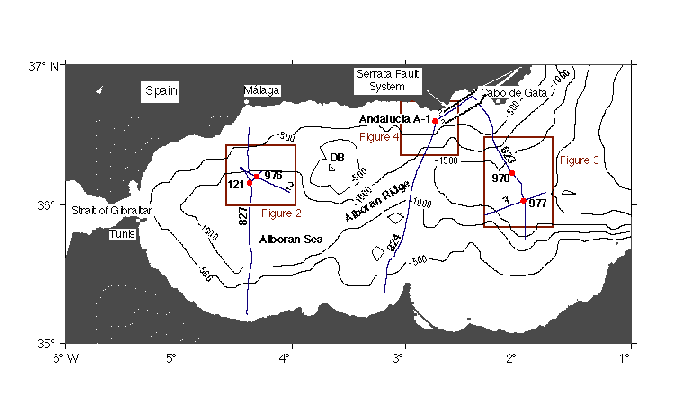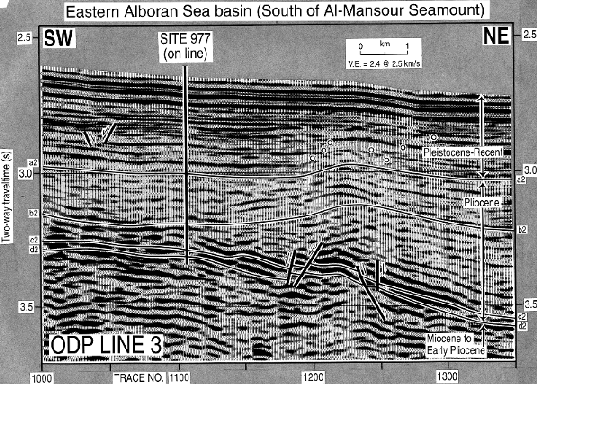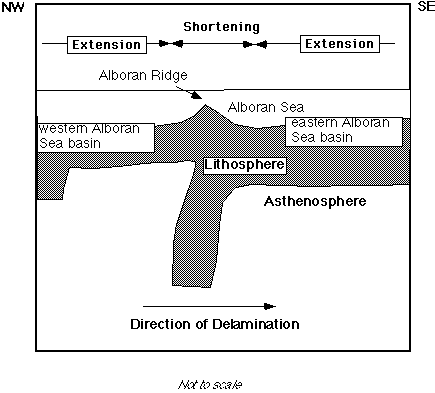|
Kush Tandon1*, Juan M. Lorenzo1 and Joaquin de La Linde Rubio2
In press: Marine Geology 1Department of Geology & Geophysics, Louisiana State University, Baton Rouge, LA-70803-4101, USA (Email: kush@gypsum.geol.lsu.edu, juan@tellus.geol.lsu.edu; Fax: 504-388-2302) 2Instituto Andaluz de Ciencias de Tierra, C. S. I. C and University of Granada, 18071 Granada, Spain (Email: jlinde@goliat.ugr.es; Fax: 34-58-243384) ______________________________________________________________________________ * To whom the correspondence should be addressed Timing of Rifting in the Alboran Sea Basin -- Correlation
of Borehole (ODP Leg 161 and Andalucia A-1) to Seismic Reflection Data:
Implications for Basin Formation
Abstract To constrain the timing of rifting in the western, eastern, and northern parts of the Alboran Sea basin, seismic reflectors corresponding to biostratigraphic boundaries and unconformities from Miocene to Recent are correlated using synthetic seismograms. Regions of adjacent coeval compression and extension are found in the Alboran Sea basin. Normal faulting continues in parts of the eastern Alboran Sea basin later than in the western Alboran Sea basin. Seismic reflection data in the vicinity of ODP Site 976 (western Alboran Sea basin) suggest that rifting ended in the Miocene. Near Site 976 (western Alboran Sea basin), no compressional features affect Miocene and younger sediments. In the eastern Alboran Sea basin north of Al-Mansour Seamount (ODP Site 977), normal faults are observed in Miocene and Early Pliocene sediments. Later, folds affect Pleistocene-Recent sediments in the eastern Alboran Sea basin (Site 977). After the folding event, there is evidence for normal faulting in Pleistocene-Recent sediments close to Site 977. South of Al-Mansour Seamount (ODP Site 978), compressional features in the eastern Alboran Sea basin from Miocene-Recent are evidenced by reverse faulting followed by folding. In the northern Alboran Sea basin (Andalucia A-1 well), there is evidence for strike-slip faulting in the late Miocene that can be related to the Serrata Fault System. We envision the development of the Alboran Sea basin through a southeasterly migration of the delaminating continental lithosphere to explain younger extension in the eastern Alboran Sea basin. The rate of the migration of the delamination front is of the range of mm-cm/ yr. We see evidence for the migration of the delamination front from Miocene-Recent as tectonic inversion occurs near Site 977. In contradiction to an extensional collapse hypothesis for the formation of the Alboran Sea, rifting did not end in the late Miocene in the entire Alboran Sea basin. We exclude retreating subduction in a westward direction or a westward continental delamination as a model for Alboran Sea basin development because it would predict younger extension in the western part of the basin. KEYWORDS: Alboran Sea; Basin formation; Continental rifting; Delamination; ODP; Synthetic Seismograms
Figure : Bathymetric map for the Alboran Sea contoured at 500 m intervals. Ship tracks for ODP Leg 161 underway geophysics and R/ V Robert D. Conrad survey (Cruise RC2911) used in this study are shown in solid lines. Lines 2 and 3 belong to ODP Leg 161 single-channel survey and lines 823, 824, and 827 to multi-channel Cruise RC2911. Filled circles locate ODP sites (976, 977, and 978), DSDP site (121) and the industry well, Andalucia A-1. Rectangular regions around the drill sites locate Figures 2-4. Dashed lines are the inferred continuation of the Serrata Fault System offshore. DB = Djibouti Bank (Woodside and Maldonado, 1992)
Figure: Interpreted seismic profile through Site 977. See map above for location.
Figure: Schematic model for the southeastward migration of delaminating
lithosphere (Channell and Mareschal, 1989; Docherty and Banda, 1995)
|


